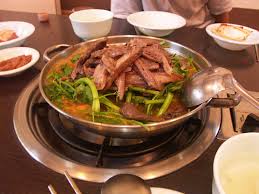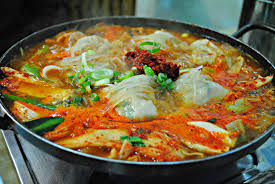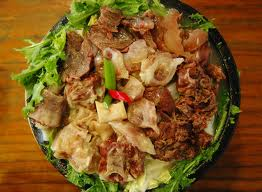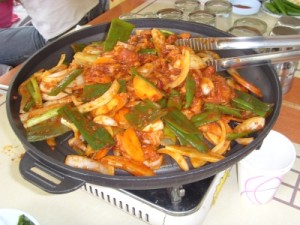When times get bad, feral dogs will be valued most as a potential food source. Open your own Korean restaurant!
Also visit Cook your Pet
Cuisine of Dog Meat
1) Bosintang (soup)
Dog Soup is called, Gaejang, Gajangkuk, or Gujang, Gujangaeng, Guyoukgeng. It has been called Bosintang from the later part of 1940, but during the period of the 1988 Olympic games, it was banned to use the name of Bosintang, so its name was replaced by Youngyangtang, Sacheoltang, Mungmungtang. But nowadays, the name of Bosintang is widely used instead of Youngyangtang. Bosintang is made by boiling dog meat with thin soy paste, tearing it into pieces, putting ingredients such as green onion, leek, stalk of taro, brake into broth, and boiling it again to make Bosintang. In Kyungsang province, to get rid of the smell, perilla purple are put in the soup. Perilla are also used for ridding the smell. Taste of perilla is similar to that of dog, and it becomes a good match to dog meat. Side dishes of dog meat are Kimchi, fresh peppers, and cucumbers. Adding a glass of Soju(liquor) enhances the taste.
The standard amount of ingredients for one portion.
Ingredients
100g of boiled dog meat
500g of gravy
20g of green onion
10g of a leek
10g of perilla leaves
100g of taro stalk soaked in water.
Sauce
8g of salt
2g of mashed garlic
3g of perilla
2g of red pepper
2g of mashed ginger
a little amount of pepper.
Cooking instruction
After boiling the meat with gravy and stalk of taro for some time, boil again after putting vegetables and other ingredients into it. Before eating, sprinkle pepper on it and put into an earthen bowl. The stalk of taro is to be kept in cold water one or two days to get rid of its smell and taste.
2. Jeongol (boiled dog meat mixed with spices and vegetables)
Eat while boiling to boil down some of the soup. Add lots of dog meat and ingredients. Vegetables such as dropwort, perilla leaves, green onion and other ingredients such as garlic, pepper, and red pepper are put in. It can be served for a side dish with Soju (liquor) or for eating boiled rice. After eating, boiled rice can be mixed with the remaining soup.
The standard amount of ingredients for one portion.
Ingredients
200g of boiled dog meat
150g of gravy
50g of green onion
50g of leek
40g of dropwort
20g of perilla
Sauce
3g of salt
5g of perilla
10g of mashed garlic
2g of red pepper
a little amount of pepper.
Cooking Instructions
Eat while boiling the soup, dog meat, gravy, vegetables and other ingredients in a pan. If it is excessively boiled, the color of vegetables can be changed, deteriorating the taste of the soup. So once it is boiled, cooking over a weak fire, begin eating.
3. Suyuk(a boiled dog meat)
Suyuk is eaten with specific ingredients or salt. Add heat to the meat by boiling water or steam for prevention from cooling down. Ingredients are to be made of the mixture of soy bean paste with perilla, and one can eat the dog meat with the addition of salt or these ingredients and wrapping it with perilla and lettuce. Eating it with mildly-boiled leek is common. When eating Suyuk, Soju(liquor) is usually accompanied by for its taste.
The standard amount of ingredients for one portion.
Ingredients
200g of boiled dog meat
50g of gravy
1g of salt
1g of garlic
a little amount of pepper, leek, perilla leaves
Sauce
It can be enjoyed at one’s taste with the addition of mixture of soy bean paste, sesame oil, perilla oil, or with salt on it.
Cooking instructions
Put dog meat and gravy and ingredients into pan, and steam it with a weak fire, eat with sauce. One can eat with boiled-leek. Perilla powder, perilla oil, mustard, vinegar are to be added to the sauce.
4. Duruchigi (mixture with seasonings)
It is a food made by mixing dog meat with seasonings and vegetables, and boiling and roasting them. When eating Duruchigi, Soju(liquor) is usually accompanied for its taste.
The standard amount of ingredients for one portion.
Ingredients
200g of boiled dog meat
20ml of gravy
50g of green onion
50g of leek
40g of dropwort
20g of perilla leave
a little pepper
5g of perilla oil
1g of salt
2g of mashed garlic
2g of mashed ginger
2g of red pepper
Cooking instructions
Put gravy and vegetables into heated pan and roast them, and after vegetables become softened, put dog meat and ingredients into the pan and mix them. If it is not salty enough, dip in the sauce.
5. Dogmeat Food developed by Professor Ann
Digested dogmeat : Dogmeat hydrolyzed by protease
Dogmeat powder : Digested dog meat powder
Dogmeat extract : Water extract of digested dogmeat and medical ingredient
Dogmeat wine : Wine of wax gourd and digested dogmeat fermented by yeast
Dogmeat vinegar : Vinegar of wax gourd and digested dogmeat fermented by Acetobacter
Dogmeat red pepper paste : Red pepper paste fermented with the addition of digested dogmeat
Dogmeat soy bean paste : Soy bean paste fermented with the addition of digested dogmeat
Dogmeat soy sauce : Soy sauce fermented with the addition of digested dogmeat
Dogmeat-red pepper paste pickle : Dogmeat pickled in red pepper paste
Dogmeat Kimchi : Kimchi fermented with the addition of digested dogmeat
Dog intestine sausage : Dog intestine into which blood of dog, vegetable and dogmeat are stuffed
Dogmeat can : Canned dogmeat
Dogmeat noodle : Noodle with the addition of digested dogmeat
Dogmeat Chinese noodles : Chinese noodle with the addition of digested dogmeat
Dogmeat puree : Puree with the addition of digested dogmeat
Dogmeat soup : Soup with the addition of digested dogmeat
Dogmeat beverage : Beverage of the dilution of digested dogmeat
Dogmeat mayonnaise : Mayonnaise from vinegar, digested dogmeat, oil and egg
Dog oil mayonnaise : Mayonnaise from vinegar, dog oil and egg
Dogmeat ketchup : Ketchup from the mixture of digested dogmeat, tomato puree
Dogmeat bread : Bread with the addition of digested dogmeat
Dogmeat cooky : Cooky with the addition of digested dogmeat
Dogmeat hamburger : Hamburger pad made of dogmeat
Dogmeat cutlet : Cutlet made of dogmeat
Dogmeat ham : Ham made of dogmeat
Dogmeat sausage : Sausage made of dogmeat
Dogmeat cosmetics : Cream, essence and emulsion made from dog oil



